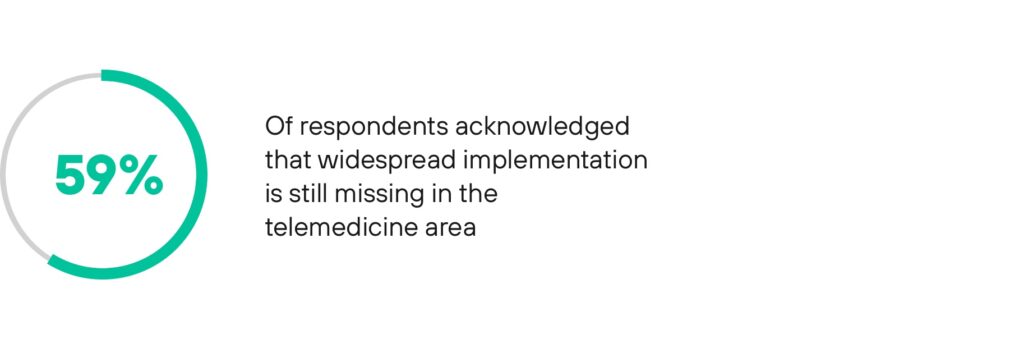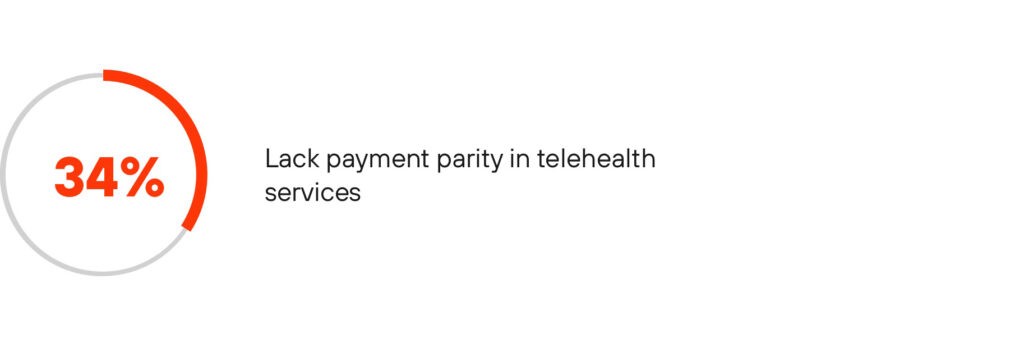Driving meaningful connections and enhancing customer engagement in life sciences
Learn about the most critical aspects of customer engagement and how to build and implement a reliable strategy for long-term success.

In this article, we’d like to share with you our telehealth survey results and also outline key takeaways from our participation in the largest telehealth innovation conference — ATA 2020, or American Telemedicine Association’s 2020 Virtual Conference and Expo.
At Avenga, we were very excited about being a part of this event. At a time when telehealth is more relevant than ever before, ATA managed to unite the brightest minds in telehealth during over 150 sessions where ideas were exchanged about integrating virtual telecare into the homes of every patient.
Right after ATA wrapped up, we conducted a short telehealth survey among the industry experts to investigate today’s critical needs of telehealth and telemedicine. Here’s what we discovered.

Almost ⅔ of respondents to Avenga’s telehealth leaders’ survey acknowledged that widespread implementation is still missing in the telemedicine area. Accessibility and access are the main bottlenecks that halt the telehealth adoption. Though telemedicine has greatly transformed the way patients communicate with doctors and has enhanced the opportunities for doctors to exchange ideas between each other, not everyone is able to enjoy the benefits it provides. Billions of people all over the world still do not have a stable broadband internet connection. According to the International Telecommunications Union, 1 of every 2 people all over the world lack access to the internet. These people are completely left out of the digital revolution happening in the healthcare domain which could significantly optimize and improve the way they get care.
“Too many patients are still going without care that is absolutely vital to their health and putting essential medical procedures on hold due to the pandemic or lack of access to care. Making recently expanded telehealth access permanent will improve patients’ ability to get care outside of doctors’ offices and other traditional health care settings and save and improve countless lives.”
Scott Whitaker, President and CEO, AdvaMed
Still, there are geographic and site restrictions for patients to access telemedicine care at home. Namely, Section 1834(m) of the Social Security Act and its geographic limitation that restricts patients across the US in their use of telecare at home or at the location they have chosen.
Thanks to COVID-19, patient usage of telemedicine has grown from 11% in 2019 to 46% in 2020. Further, 76% of patients acknowledged that they would be happy to use telehealth platforms in the future.
In March 2020, the Cleveland Clinic conducted over 60,000 telehealth consultations, increasing their web traffic by 18 times their monthly average. However, just 2 in 10 clinicians are planning to implement telemedicine appointments and only 1 in 10 hospitals have the needed technology for large-scale telehealth implementation. This challenge leaves us with room for improvement.

As per Avenga’s telehealth survey, half of the respondents said they need AI and chatbots to make telehealth work more efficiently.
Some predictions estimate that using AI solutions could result in savings of up to $150 billion annually by 2026. AI has started to infiltrate the healthcare market at a rapid pace, being a powerful tool that speeds up improvements across the healthcare domain.
Thanks to current advances in digital technology, patients can get instant help with all their health questions from an artificial intelligence (AI) chatbot. Medical chatbots built on AI and machine learning (ML) technology are self-learning and self-improving, and they get better in answering patients’ questions every day. Health AI chatbots are really helpful in identifying high-risk health situations and they save the doctor’s time by answering the patient’s most common questions.
What is more, a great benefit of AI chatbots for virtual care is that they can provide a comprehensive response immediately, seconds after the patient has typed in their question. Chatbots are capable of serving patients 24/7/365, thus justifying the expenses spent on developing and educating a telemedicine chatbot.
Further, a health chatbot built using ML is constantly polishing its answers and learning to be better. By having access to comprehensive data on various diseases and health conditions, it has the potential to be a comprehensive diagnostic tool.
Conversational agents can greatly enhance the patient journey, including triage, referral assistance and ongoing engagement. This topic was explored in greater detail in the panel discussion that took place at ATA 2020: Conversational Agents and Telehealth Virtual Visits: Improving Experiences, Efficiency and Outcomes.

Forty-two percent (42%) of telemedicine survey respondents agreed they lack clinical decision support. Clinical decisions are harder when there are patients who have multiple chronic diseases. For example, for a person who has heart failure, diabetes and asthma it may not be that easy to find a treatment as the treatment for each diagnosis conflicts with each other.
The only way to manage conflicting treatments is to collect volumes of data over long time periods, and then analyze and label the data to see which patients are healthier. The patients can be combined into cohorts and comprehensively monitored with the help of telemedicine and telehealth to inform healthcare decisions.
Big data analysis can support the work of practitioners. Utilizing a predictive analytics system that integrates into home monitoring will help to keep a larger number of patients healthy. Predictive analytics systems can help to shift the focus from treatment of the individual’s illnesses to treating the individuals.
Adoption of clinical informatics systems streamline the “inevitable telehealth momentum”. With the help of AI and ML, clinical informatics has the potential to streamline clinical decision support, improve medical outcomes and reduce expenditures.
“It’s clear that more states are adopting telehealth solutions, but some lack the authority or resources needed to fully deploy telehealth across the state. ATA supports expanding research opportunities to increase innovation and reduce costs, to help incentivize states to continue to adopt telehealth services.” Ann Mond Johnson, CEO, the American Telemedicine Association (ATA)

As per our telehealth survey, a third of respondents acknowledged the lack in reimbursement payment parity in telehealth services. This obstacle hinders a wider telemedicine adoption and is a crucial barrier to telemedicine adoption in the post-pandemic world. Because of the coronavirus emergency, 44 states in the US and the District of Columbia have expanded the payment reimbursement for some form of telemedicine. Still, many of those reimbursement policies have restrictions and limitations, creating barriers for full telehealth utilization.
“As we all work to understand the impact of the waivers put in place in response to the pandemic and assess what should be made permanent, we encourage Congressional leaders to focus on existing statutory barriers that must be immediately addressed to ensure the administration can appropriately transition and modernize telehealth under Medicare and importantly, keep us all from falling off the ‘telehealth cliff.” Ann Mond Johnson, CEO, the American Telemedicine Association (ATA)
Payment reimbursement for telehealth and telemedicine video sessions far exceeds reimbursements for remote patient monitoring, with only 23 states having implemented reimbursement for patient monitoring via virtual care, according to State Telehealth Laws and Reimbursement Policies published in Spring 2020.
Just 16 states are reimbursing the costs for store-and-forward telemedicine. In store-and-forward telehealth, patients can record a video or audio and it’s stored at an intermediate station for the physician to review later. Out of these 16 states there are certain limitations on what can be reimbursed. For example, in Maryland, dermatology, ophthalmology and radiology store-and-forward care is not reimbursed by the insurers.
Email, telephone and fax are silently excluded from reimbursement unless they are in conjunction with other types of care. Email and telephone are explicitly excluded in some state programs and so they don’t fall under the definition of telemedicine and/or telehealth.
“I have seen first-hand the many ways telehealth bridges the gap between a critical provider shortage and a growing patient population – a problem that existed prior to the pandemic, and one that will only worsen,” said Joe Kvedar, Professor, Harvard Medical School, Senior Advisor, Virtual Care, Mass General Brigham (Partners HealthCare), and ATA President. “However, we need Congress’ support to ensure patients and providers do not go over the telehealth ‘cliff’ as our nation eventually emerges from the pandemic. We must make sure that essential telehealth services do not abruptly end with the public health emergency, especially as we look to reorient our healthcare system to deliver 21st-century care.”
Even though during the COVID-19 pandemic telehealth services have become more accessible than they were before, after the emergency ends care providers might not be as eager to reimburse costs for telehealth visits as they were during the pandemic.
→ How telemedicine and telehealth are helping us to tackle the coronavirus pandemic

A quarter of the respondents of the telehealth leader’s survey agree they lack quick new functionality implementation. Such intent has become very relevant over the last half a year, when telemedicine apps experienced thousands of requests per second and were not ready at all to handle such high loads.
One of the biggest challenges to implement new features and functions in telehealth apps is the lack of consistent and standardized development processes. Thorough app standardization takes time, while the maintenance of telemedicine apps is much easier but time-consuming.
The second challenge of quick new functionality implementation is the speed itself. In the current times, telemedicine app providers are under intense pressure to deliver viable solutions quickly, without sacrificing functionality or security.
The third challenge within deployment of the new functionality for telehealth apps is the rising number of cyberattacks. According to the PT Security report, 50% of web apps contain high-risk vulnerabilities. This is especially relevant for telemedicine apps as they potentially contain sensitive information about patients.
The fourth challenge is integration complications. As the number of platforms, apps and systems used by healthcare institutions is growing exponentially, here comes the issue of how to ensure the multiple systems work well together.
The fifth and the last challenge for new feature implementation for telehealth apps is resilience in its design and the availability of reliable architecture that can perform during high-load times and handle huge volumes of server requests. Avenga can help you with app development and software architecture design that will assist you to scale your app performance and fault tolerance. Get in touch with us to build a secure, reliable, effective and scalable telehealth app.
“The IT department was going “heavy” on its technology roadmap, implementing new technologies. About half of Seattle’s children’s non-emergency visits are hosted through telehealth services today. I wouldn’t necessarily see anything that we could have done differently. It’s more about the speed at which we can accelerate, to actually put the things in place that need to be put in place.”
Gary Gooden, CISO of Seattle Children’s

One-fourth (¼) of the telemedicine ine industry leader’s survey respondents acknowledged the necessity in streamlining consent procedures.
Thanks to the 1135 waiver, as of March 6, 2020, Medicare has started to reimburse payments for telemedicine visits. Furter, the HHS Office of the Inspector General allowed clinicians to cut down expenditure-sharing for telemedicine visits paid by government healthcare programs.
The coronavirus pandemic shortened the time frame for regulatory approvals from years to months and, in some cases, to several weeks. Still, many hospitals in the US require written consent from a patient to be able to deliver telemedicine.
“We need to get this moment in healthcare right by optimizing the quality and value of telehealth for everyone,” said Margaret E. O’Kane, President of the National Committee for Quality Assurance
Additionally, The Centers for Medicare & Medicaid Services has expanded Medicare coverage to enable patients to get broader access to telemedicine services and they also loosened regulations around practicing medicine across US state lines. Now physicians are able to practice telehealth and telemedicine across state borders.
In order to accelerate the telehealth adoption during the coronavirus emergency, the Department of Health and Human Services temporarily loosened regulations under the Health Insurance Portability and Accountability Act (HIPAA). Updated HIPAA privacy rules allow doctors to communicate with patients using different video-conferencing platforms like Facebook Messenger video chat, Google Hangouts, Apple Facetime, Skep and Zoom.
Additionally, the Department of Justice’s Drug Enforcement Administration (DEA) has relaxed its requirements by allowing healthcare professionals to prescribe controlled drugs through telehealth, such as opiates, without requiring an in-person visit. In such ways doctors have been able to provide patients all the necessary healthcare services in the interim.
During ATA 2020 Avenga launched a next-gen digital solution that assists economies in returning to normal. In the provided 7-minute video you can discover how our new project makes the post-quarantine reality secure. Avenga, together with UBIRCH GmbH and Accu Reference Medical Lab, built a solution that helps employees get back to work and their social lives safely. With the help of our smart secured test result system, people can easily show their COVID-19 test lab results to any relevant parties without compromising privacy and data safety.
The healthcare trends have changed drastically in the last half a year. Patients are using digital methods not only to get the latest news on the pandemic, but also using telehealth and telemedicine as a safe and secure way to connect with physicians. Healthcare institutions are increasingly exchanging and sharing data between each other, enabling the creation of feedback loops that are very helpful in coping in these uncertain times.
Telemedicine visits have largely replaced live visits. Nowadays, 147 million people in the world live with chronic health conditions, accounting for 90% of healthcare expenditures. With telemedicine we can empower better access to healthcare while cutting the costs of long term health complications. Remote monitoring conducted via telehealth platforms allows patients to keep track of their health and reduce hospital visits, as well as regain the time they previously spent for travelling to clinical sites.
By empowering patients to visit clinicians virtually, and by enabling doctors to connect with patients, telemedicine services have made a substantial contribution to halting the COVID-19 outbreak. Telehealth services undeniably will continue to grow at a constant pace all over the world, helping healthcare to advance and progress. Health organizations that utilize a forward-thinking approach to organize and amplify virtual care services will be better prepared to succeed in the emerging healthcare and life sciences landscape.
Of course, telehealth will not fully replace real-live diagnostics in the post-pandemic world. Telemedicine is just an option for patients to get care.
In short, the future is in telehealth and digital transformation is driving the progress forward. Let’s embrace the innovations and new ways of thinking in order to make the healthcare future even brighter.
Avenga has been at the forefront of designing and developing innovative telemedicine solutions. For one of our clients we developed a telehealth suite that allows health providers and patients to overcome barriers to healthcare, whether at home or at work.
Avenga’s excellent command of artificial intelligence (AI), machine learning (ML), and business intelligence technologies coupled with our ability to harness vast amounts of data collected from patients and clinics, helps health professionals to make better medical decisions through big data analytics, meanwhile providing an opportunity to be proactive rather than reactive to medical issues. If you want more information regarding developing a telemedicine app for you, reach out to us using the form below.
Ready to innovate your business?
We are! Let’s kick-off our journey to success!